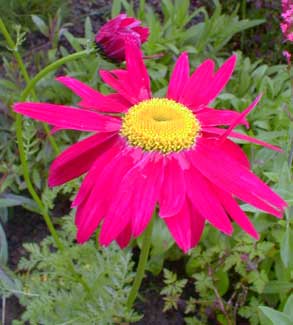
'Double Market Red'
Painted Daisy; aka:
Pyrethrum, Persian Pellitory,
Painted Ladies or Feverfew
"Bright Flower! whose home is everywhere,
Bold in maternal Nature's care."
-To the Daisy
by William Wordsworth
(1770-1850)
by William Wordsworth
(1770-1850)
Tanecetum coccineum or painted daisies were formerly caled Pyrethrum roseum, & still often called Pyrethrum Daisies as a common name. They were once also assigned the name Chrysanthemum roseum.
Annoyed by this flower's shifting nomenclature, an anonymous author writing for the New Ornamentals Society rather hotly declared the oldest name to be the preferred one, because name changes "have no merit unless one respects a rather cavalier type of taxonomy that requires generic name adjustments every single decade," which is not the usual attitude whether among ordinary gardeners, professional horticulturalists, or taxonomists, despite that it can be frustrating trying to keep abreast of current standing for the names of every plant one has.
They are native from Turkey to subalpine meadows of the Caucusus Mountains. In our zone Painted Daisies bloom sometimes by May certainly for June & July. If the spent flowers & their stems are cut to the ground, rebloom can be expected in late summer, but if permitted to go to seed it will be finished for the season.
Besides the deep red, painted daisies can also be had in white or in shades of pink or purple, but the red is my favorite. The tall stems can be floppy especially if the plant is not getting enough sun.
Staking may be inescapable but they may lean more tidily with plenty of sun; they may provide the good excuse to put a very fancy wooden or bamboo or wicker-woven tomato pyramid in the garden & let the Painted Daisies grow through it. However, most painted daisies grow to three feet tall, whereas the 'Double Market' series tends to be only two feet tall (above ferny basal foliage reminiscent of achillea foliage), & will often stand sufficiently upright that staking isn't demanded.
It adjusts to a wide range of soil types & conditions from alkaline to acidic, light to heavy (sandy to clayey), & dry to moist, but ideal is moist very well draining soil with neutral pH. Extremely cold-hardy, it can be gardened in zones three through eight. They are not very heat-hardy despite wanting full sun. Clumps can be divided in autumn or at the end of winter.
The seeds from the yellow eyes of Tanacetm coccineum & T. cinerariifolium are the source of the insecticide pyrethrin which is non-toxic to mammals. The dried flowers were traditionally dried, powdered, & used insecticidally around the home such as in closets & chests. Because the chemical breaks down rapidly when exposed to sunlight it is regarded as the safest & least persisting of insecticides, but can nevertheless be harmful to fish. The popular brand Raid has pyrethrin as a major ingredient.